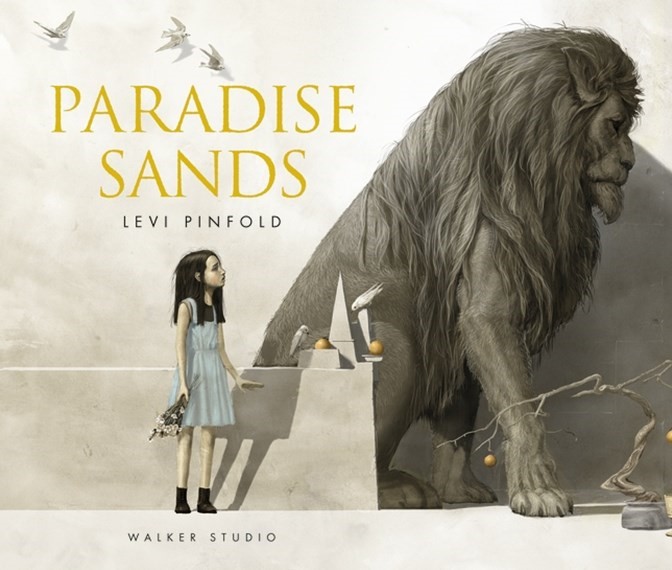Where do ideas come from, readers often ask. Levi Pinfold explains that for ‘Paradise Sands’, ‘I wanted to explore how our desires, particularly our desire to forget, can be manipulated. But also, how our more noble inclinations can be used against us by a system or power structure. Perhaps something about the unseen sacrifices we make fed in to it too. And Faeries, of course.’ (source: Arena Illustration)
Remove the book’s jacket cover and there is a grey and sage green wrap-around illustration that reveals a vast and desolate landscape. A mystical six-line rhyme on the opening page warns the reader. Three teenage boys and their younger sister travel by car to visit their Mum, stopping at Teller’s Hollow to pick white roses for her. Hot and thirsty, they drink from the spring then make their way into a looming, eerie white building. The young narrator cautions her brothers who wash clean in a pool then transform into dolphins.
Enter the Teller, a large lion. He invites the young girl to drink, but she refuses. The Teller reveals the brothers took what was offered, so now they must remain. The Teller offers the young girl a challenge. If she can refuse eating and drinking for three days, then things will be as they were. A double page scene reminiscent of the biblical ‘Last Supper’ features a banquet attended by a collection of animals, perhaps ensnared humans. The girl neither eats nor drinks, but she gives a little water to her flowers.
The Teller then accuses the young girl of breaking the bargain by giving water to the flowers. She demands that her brothers be released. The building, residents and the Teller explode into a whirlwind of swirling dust. The Teller pronounces, ‘one day your own daughters and sons will visit me here and, if they choose to stay, they are mine’. When the brothers and their younger sister arrive to visit their Mum, the young girl presents the flowers which Mum carefully inspects and asks if they come from Teller’s Hollow. That exchange sends a shiver through readers who realise that Mum made a bargain with the Teller.
Familiar fairy and folk tales come to mind where things are not as they seem and where stories are open-ended. As eerie as the text is, with its underlying threats, Pinfold’s illustrations add a layer of dread. These illustrations are masterful realistic artworks in shades of soft brown and grey featuring foreboding shadows and haunting details. ‘Paradise Sands’ offers a surreal, mesmerising and unforgettable experience. Levi Pinfold’s artwork has been described as ‘stylised realism – creating his imagery from imagination’. Among his many awards is the British Kate Greenaway Medal for ‘Black Dog’, his second picture book, published in 2013. He lives in Australia.

